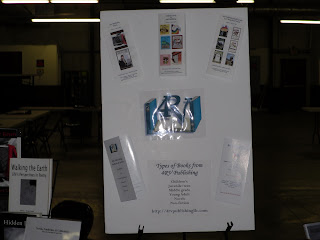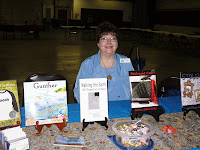Katherine Boyer reviewed The Giving Meadow, by Stephanie Burkhart and illustrated by Stephen Macquignon, for The Midwest Book Review. The review appeared in the September issue of "Katherine's Bookshelf."
Review by Katherine Boyer:
The Giving Meadow
Stephanie Burkhart
4RV Publishing LLC
PO Box 6482, Edmond OK 73083
9780982588697 $17.99
The life cycle of any aspect of nature written for children can be and usually is a great learning experience for them. Stephanie Burkhart's book, The Giving Meadow is no exception.
When an egg lands in a meadow, the creature that emerges goes through the life cycle of a caterpillar until he wraps himself in a cocoon.
When he was a growing caterpillar, he met and was helped by several very diverse residents of the meadow, a frog, a ladybug, a bee, and a snake.
The lessons depicted in this lovely, brightly illustrated book include, but are not limited to, sharing, friendship, acceptance, understanding and generosity. The friends that the caterpillar makes on his journey to adulthood generously share their bounty with him that he accepts graciously because he knows they understand that he needs their help as he travels on his journey to complete his life cycle.
"The snake told the bee.
The bee told the ladybug.
The ladybug told the frog.
All the caterpillar's friends waited."
The wait was not in vain. The sight that greeted them was a beautiful creature. You must read this book to learn about this amazing metamorphosis.
Children from 4-8, and even some a little younger and a little older, will want to read this book over and over. Younger non-readers will soon begin to anticipate the story and help tell it. You will enjoy reading it to them and watch in excitement as they discover something new in the story or in the illustrations. Older readers will want to re-read and pour over the pictures as they discover more exciting things.
Stephanie Burkhart, originally from New Hampshire, now lives in California with her husband, Brent and her two sons, Andrew and Joseph. She began writing homemade comic books at five years old and hasn't looked back, as she now writes short stories and novels. This is her first children's book.
Katherine Boyer
Reviewer
Stephanie Burkhart
4RV Publishing LLC
PO Box 6482, Edmond OK 73083
9780982588697 $17.99
The life cycle of any aspect of nature written for children can be and usually is a great learning experience for them. Stephanie Burkhart's book, The Giving Meadow is no exception.
When an egg lands in a meadow, the creature that emerges goes through the life cycle of a caterpillar until he wraps himself in a cocoon.
When he was a growing caterpillar, he met and was helped by several very diverse residents of the meadow, a frog, a ladybug, a bee, and a snake.
The lessons depicted in this lovely, brightly illustrated book include, but are not limited to, sharing, friendship, acceptance, understanding and generosity. The friends that the caterpillar makes on his journey to adulthood generously share their bounty with him that he accepts graciously because he knows they understand that he needs their help as he travels on his journey to complete his life cycle.
"The snake told the bee.
The bee told the ladybug.
The ladybug told the frog.
All the caterpillar's friends waited."
The wait was not in vain. The sight that greeted them was a beautiful creature. You must read this book to learn about this amazing metamorphosis.
Children from 4-8, and even some a little younger and a little older, will want to read this book over and over. Younger non-readers will soon begin to anticipate the story and help tell it. You will enjoy reading it to them and watch in excitement as they discover something new in the story or in the illustrations. Older readers will want to re-read and pour over the pictures as they discover more exciting things.
Stephanie Burkhart, originally from New Hampshire, now lives in California with her husband, Brent and her two sons, Andrew and Joseph. She began writing homemade comic books at five years old and hasn't looked back, as she now writes short stories and novels. This is her first children's book.
Katherine Boyer
Reviewer
The Giving Meadow is now on sale for the holidays at the 4RV Bookstore.
























